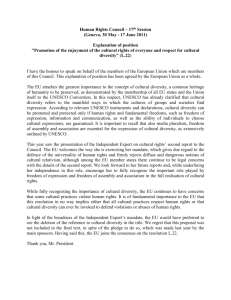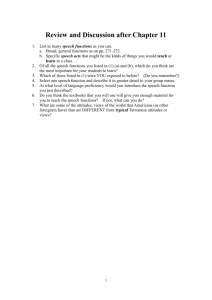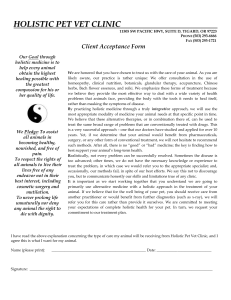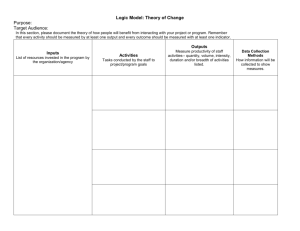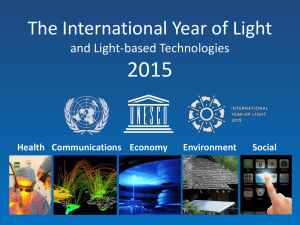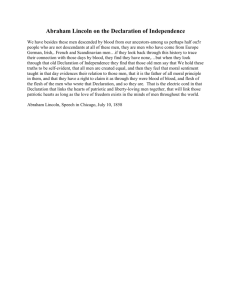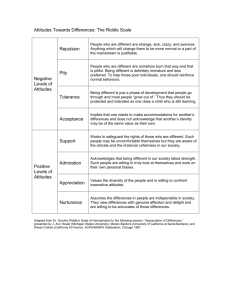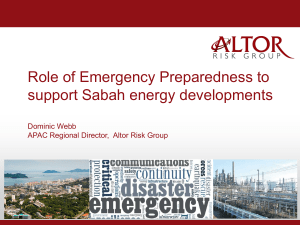I. The Values Dimension in Quality Education
advertisement
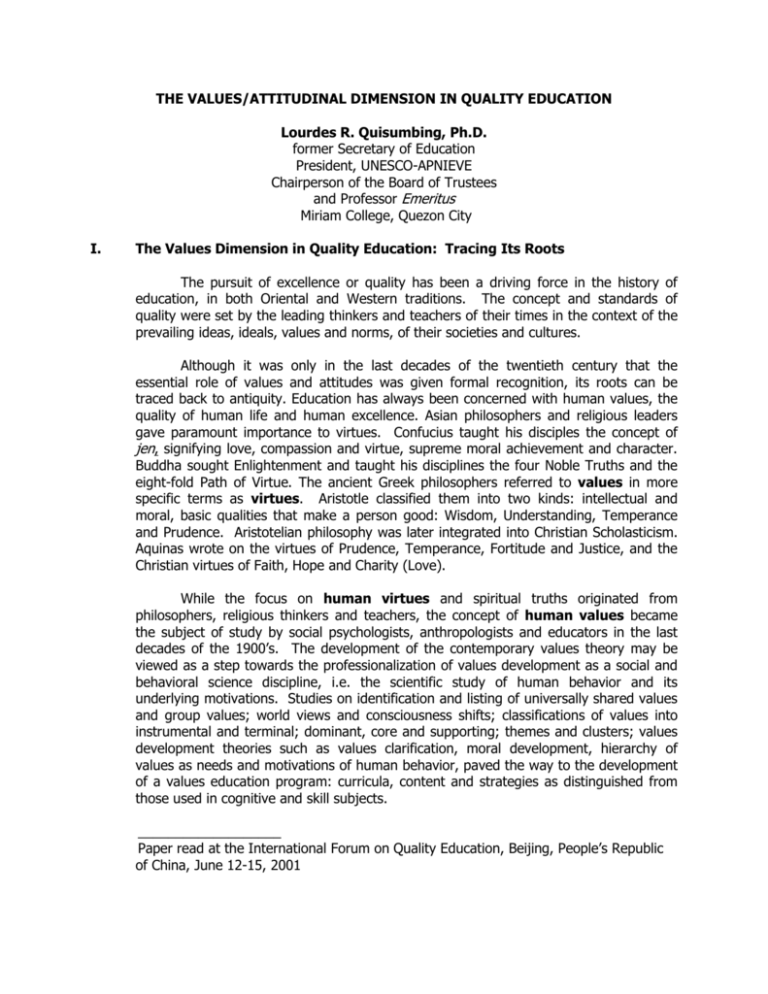
THE VALUES/ATTITUDINAL DIMENSION IN QUALITY EDUCATION Lourdes R. Quisumbing, Ph.D. former Secretary of Education President, UNESCO-APNIEVE Chairperson of the Board of Trustees and Professor Emeritus Miriam College, Quezon City I. The Values Dimension in Quality Education: Tracing Its Roots The pursuit of excellence or quality has been a driving force in the history of education, in both Oriental and Western traditions. The concept and standards of quality were set by the leading thinkers and teachers of their times in the context of the prevailing ideas, ideals, values and norms, of their societies and cultures. Although it was only in the last decades of the twentieth century that the essential role of values and attitudes was given formal recognition, its roots can be traced back to antiquity. Education has always been concerned with human values, the quality of human life and human excellence. Asian philosophers and religious leaders gave paramount importance to virtues. Confucius taught his disciples the concept of jen, signifying love, compassion and virtue, supreme moral achievement and character. Buddha sought Enlightenment and taught his disciplines the four Noble Truths and the eight-fold Path of Virtue. The ancient Greek philosophers referred to values in more specific terms as virtues. Aristotle classified them into two kinds: intellectual and moral, basic qualities that make a person good: Wisdom, Understanding, Temperance and Prudence. Aristotelian philosophy was later integrated into Christian Scholasticism. Aquinas wrote on the virtues of Prudence, Temperance, Fortitude and Justice, and the Christian virtues of Faith, Hope and Charity (Love). While the focus on human virtues and spiritual truths originated from philosophers, religious thinkers and teachers, the concept of human values became the subject of study by social psychologists, anthropologists and educators in the last decades of the 1900’s. The development of the contemporary values theory may be viewed as a step towards the professionalization of values development as a social and behavioral science discipline, i.e. the scientific study of human behavior and its underlying motivations. Studies on identification and listing of universally shared values and group values; world views and consciousness shifts; classifications of values into instrumental and terminal; dominant, core and supporting; themes and clusters; values development theories such as values clarification, moral development, hierarchy of values as needs and motivations of human behavior, paved the way to the development of a values education program: curricula, content and strategies as distinguished from those used in cognitive and skill subjects. ___________________ Paper read at the International Forum on Quality Education, Beijing, People’s Republic of China, June 12-15, 2001 II. Current Definitions of Quality Education: Standards and Indicators of Quality In recent times, quality education has been defined in more pragmatic terms from an instrumentalist point of view. Assessed in relation to national governments’ five- or 10-year development plans, educational quality was measured mostly in economic terms vis-à-vis national development goals and quantitative targets. In the advent of globalism, educational quality is being equated to competitiveness of graduates in the global market. consisting mostly of the skills and competencies needed in the new ICTs in preparation for a knowledge-based, information society. Students are viewed as human capital and as national resource, as an investment in the national economy. Priority is placed on courses directly contributing to the national development goals. Thus, success in education has become synonymous with employability, preparation for the world of work or as instrumental to the enforcement of law and order and to social cohesion. Less and less consideration is given to the subject and object of education, which is first and foremost, the full development of the student as a human person. Lately, the improvement of the quality of education has become a global concern. Stress is placed on the importance of the quality of teaching and of learning outcomes. Quality has become a key issue alongside with the demands for democratization of access to education with an expanded vision of education for all that includes learning opportunities for marginalized populations and out-of-school youth and measures success not so much in terms of the number of years of schooling but rather in the quality of learning outcomes. The 1990 Jomtien Declaration of Education for All defined basic education as the fundamental knowledges, values and attitudes, skills and competencies needed for an individual to survive, to live and work in dignity, and to continue learning. The 2000 Dakar Framework of Action is committed to improving all aspects of the quality of education and ensuring excellence of all, through diversification of contents and methods, and the promotion of universally shared values. The global educational community stated in the UNESCO medium-term plan of 1992-1998 that values education is an integral part of basic education. More than a hundred Ministers of Education signed the 1994 Geneva Declaration and Framework for Action on Education for Peace, Human Rights and Democracy for their respective countries. To support this initiative, UNESCO-APNIEVE, the Asia-Pacific Network for International Education and Values Education, has espoused the writing of sourcebooks and the training of teachers for education on the values of peace, human rights, democracy and sustainable development, as well as on the valuing process. The UN Declaration of the year 2000 as the International Year of a Culture of Peace defines culture of peace as the “set of values, attitudes, modes of behaviour and ways of life that reflect and inspire respect for life and all human rights,” rejection of violence and devotion to the principles of freedom, justice, democracy, tolerance, cooperation, pluralism, dialogue and understanding among diverse groups of peoples (Article 1). A culture of peace aims at “transforming values, attitudes and behaviours to those which promote a culture of peace” (Article 3). “Education is the principal means to build a culture of peace. Every aspect of education should be mobilized towards this end” (Article 6). Those engaged in scientific philosophical and creative activity have a special role to play in promoting the dynamic development and sharing of knowledge, research and artistic production which foster a culture of peace (Article 10). Indeed, this global declaration affirms the highest standards of educational quality and excellence. If quality is judged by the degree to which goals and standards are attained, then this declaration is an unmistakable call for major reform in our educational paradigms, programs and practices. Already in 1988, the Philippine Ministry of Education, convinced of the importance of values as instrumental to personal and social transformation, pioneered in the introduction of values education and attitude change in its secondary school curricula as a separate subject and the integration of values in all the elementary school subjects. Other countries took a similar initiative, stressing moral education in their national education systems. The latest attempt of the Philippine educational system to improve the quality of education was the formation of the Philippine Commission on Educational Reform (PCER) by Executive Order No. 46, December 7, 1998, In April 2000, PCER came out with the Philippine Agenda for Educational Reform highlighting two areas: 1) competency-based curricula, the main target areas of which will focus on the enhancement of knowledge, skills and attitudes—once acquired, the student will be capable of educating and training himself; and 2) good leadership in the supervision of instruction towards quality teaching. On strengthening the competencies of the teacher at the basic education level, four essential key result areas (KRAs) were identified as follows: KRA1: adept at the use and adaptation of instructional technology; KRA2: not mastery of subject matter alone, but of the ability to analyze and understand situations, i.e., reading and comprehension skills; KRA3: a way of thinking that is creative, constructively critical and innovative; and KRA4: learning and practice of values and attitudes to be able to live in harmony amidst diversity, resolve conflict non-violently and be guided by ethical norms and principles. In brief, the four KRAs are: 1) Instructional Technology (IT), 2) Reading/Comprehension Skills, 3) Critical/Analytical and Creative Thinking, and 4) Values Education. The assessment of educational quality of programs/institutions has led to the development of the voluntary accreditation system which attempts to measure quality based on established criteria and indicators. Judgments regarding quality are made in relation to some goal, purpose or norm. The most cherished values and the highest priorities of the institution provide direction to its educational programs and practices. This is articulated in the Vision-Mission Statement of the institution reflecting its philosophy, over-all goals, aims and objectives, giving it a specific character and its particular stamp of quality. Quality is viewed as the degree to which an institution or program achieves its goals. Even if not explicitly stated, or perhaps not even consciously intended, values and attitudes underlie the criteria and indicators in assessing all the areas of educational goals and objectives: administration and management, curriculum and program of studies, faculty, instruction and learning outcomes, student services, the learning environment, physical plant and facilities, instructional media, library and laboratories, research and community services. It must be stated here that the major emphasis of quality assessment should be on the human element in each area. III. The Need for a Re-definition of Quality in Education: Integrated Approach A Holistic and The grave issues in our times—ethnic conflict, violence, terrorism, genocide, war, massive displacement of peoples living in subhuman conditions, poverty, hunger, disease, ignorance, addiction, environmental decay, increase in juvenile crimes, child abuse—not only remain unsolved but have grown in almost uncontrollable proportions, despite our so-called scientific and technological advancement. How can we continue to talk about the quality of education when we cannot even begin to alleviate the human condition? How can we continue to work towards development in a violent, unjust and turbulent world? There can be no development without peace, just as there is no peace without development. A massive radical change is needed in our egoistic lifestyles, our irresponsible production and consumption patterns, our destructive ways of ravaging our environment. We must work together towards a re-education of humankind, an attitudinal and behavioral revolution of the mind, heart and will if we want to save humankind from total disaster. The challenges posed by our rapidly changing world and the major tensions that we face have been addressed by the Delors Commission in their 1996 Report to UNESCO, Learning: The Treasure Within. The new educational paradigm of Lifelong Education—learning how to learn, based on the four pillars of education: learning to know, learning to do, learning to live together and learning to be—is the master key to meet the challenges of our century. Education should be viewed as fundamental for personal and social development, as well as an instrument for peace and tolerance, nonviolence and international understanding. Quality of education will then be considered not in fragmented or purely pragmatic and instrumental terms, but in a more holistic manner, the development of all the talents of the individual; the formation of the whole person, the full flowering of all the human powers and faculties—physical, intellectual, affective, aesthetic, ethical, and spiritual, and the transformation of society. No doubt the phenomenal advances in science and technology, the information and communication revolution have made dramatic breakthroughs in our lives; but they have not prevented the breakdowns in the social moral order, the upsurge in crime and violence, the erosion of our human, ethical, cultural and spiritual values. Edgar Faure in a much earlier Report to UNESCO (1972), Learning to Be, outlines the goals of education as Scientific Humanism, Social Commitment Towards Being Completely Human in a Learning Society. This calls for a values dimension in education and society, science with a conscience and technology with a human heart at the service of humanity. It points to the holistic and integrated education of the human person in a learning society. UNESCO’s Medium Term Strategy (2002-2007) Draft 31 C/4 Contributing to peace and human development in an era of globalization has defined as its first domain of action: Culture of peace through education, and pointed out poverty and conflict as the prime causes which put human security at risk, and endangers human dignity and social justice. It calls for a globalization with a human face. In all its activities, UNESCO will be guided by the three fundamental principles of universality, diversity and dignity, closely related to the values of justice, solidarity, tolerance, sharing and equity, respect for human rights and democratic principles. Under UNESCO’s Major Programme I—Education (Draft 31 C/5), Programme 1.2 is entitled Building knowledge societies through quality education and a renewal of education systems. In Section 1.2.1 Towards a new approach to quality education, the global educational community of Member States authorizes the implementation of a plan of action in order to: promote a new approach to quality education by emphasizing the acquisition of values, attitudes and skills needed to face the challenges of contemporary society and globalization, in particular through education for a culture of peace, for human rights, for cultural and linguistic diversity and for a sustainable future. In this regard, UNESCO will seek to ensure that “quality education embraces a deep concern for the fundamental goals and purposes of education, for the relevance of learning contents and processes, and for modes of learning that reinforce human values…Viewed from this perspective, quality education encompasses the full development of the human personality, in line with the Universal Declaration of Human Rights…The concept of education for a culture of peace and sustainable development links it closely with educational themes, fields and concerns with a view to generating a holistic vision of quality education.” A holistic and integrated education towards a complete human person may seem to be an unrealistic and an impossible task, since the things that count cannot be counted, and what matters most may be invisible to the eye. It is only when we have the power to value that we will be able to distinguish the essential from the nonessential, and to realize that the dignity of the human person and the excellence of the human spirit are the ultimate criteria of quality. Finally, it may be said that standards of quality in this age of globalism and IT can be met only through a holistic and integrated approach to education which veers away from: rigid compartmentalization of content to a more multidisciplinary, interdisciplinary view of reality; authoritarian teacher-centered teaching strategies to more democratic participatory interactive learning methods; content-focused teaching to a holistic cognitive-affective-behavioral teachinglearning cycle; prepared and fixed modules to flexible and adaptable guides to teaching and learning; values-free to values-integrated subject matter with emphasis on the valuing process; mere information to formation and transformation; academic excellence alone to moral excellence, character building and personality development. A holistic, integrated and relevant education blends and interfaces local wisdom with global knowledges, values and skills, in order to develop the student to become a citizen of his/her country as well as a citizen of the global village; the new ICTs with the multiple intelligences and learning styles of the student, so that the uniqueness of the individual is not neglected; the scientific and the humanistic, the objective and the subjective, the individual and society, the physical and metaphysical, the material and spiritual. A holistic, integrated and humanistic education retains the essential meaning of Quality: the discovery and development of the talents of every individual, the full flowering of the human potential, learning to be a complete human person. After all, educare, the root word of education, means the bringing forth of the wholeness within each one of us.
